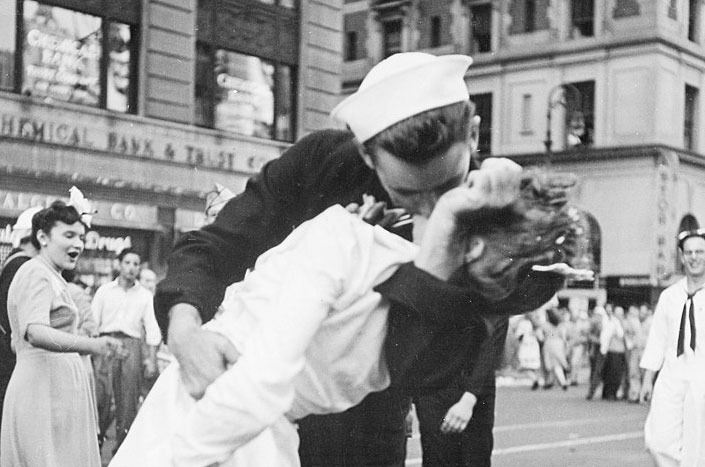Blog

DEI’s Attempt to Erase V-J Day at the VA
When our institutions erase the common history we all share as Americans to push divisive ideologies, everyone loses. But in the case of a recent attempt to hide away one of the most iconic images of the 20th century, organic grassroots action to preserve United States history saved the day.
On August 14, 1945, then-President Harry Truman gave a welcomed announcement to the war-weary American public: the Japanese, who attacked Pearl Harbor four years prior, had surrendered, officially ending World War II. Celebrations erupted throughout American cities and one specific instance in Times Square was immortalized in a famous image snapped by photographer Alfred Eisenstaedt known as the “V-J Day in Times Square” picture. The image depicts a navy officer kissing a woman in celebration of America’s victory.
Flash ahead to February 29, when Department of Veterans Affairs Assistant Under Secretary for Health Operations RimaAnn Nelson demanded the “removal and replacement of ‘V-J in Times Square’ photographs” in an internal memo. Nelson’s justification for this order was the photograph’s alleged violation of “the VA’s no-tolerance policy towards domestic violence, sexual harassment, and assault,” and that it “could be construed as a tacit endorsement of the inappropriate behavior it depicts.” The memo concludes: “To promote a culture of inclusivity and awareness…your cooperation is vital.”
The directive leaked to social media soon thereafter and sparked an online firestorm. Hours later VA Secretary Dennis McDonough said the famed photo would remain. His command was issued on X — the very platform that alerted him to the controversy in the first place.
Public pushback reverberated beyond the corridors of the VA’s office. The White House was compelled to release a statement on the matter to confirm Secretary McDonough’s comments. White House Press Secretary Karine-Jean Pierre said, “The VA is not going to be banning this photo. I can definitely say that the memo was not sanctioned, and so it’s not something that we were even aware of.”
How did this happen in the first place? Look no further than the Diversity, Equity, and Inclusion (DEI) cult, which promotes a worldview that encourages hostility to our historic past.
World War II represents a reality most Americans today may not remember, but it is an integral part of our national story that shows how the United States triumphed in one of the world’s darkest times.
It’s especially remarkable given that the 1940s were far from paradise for many Americans: segregation was still the law of the land, many Americans were divided on class lines in the wake of the Great Depression, and political divisions put many Americans at odds. And yet, the spirit of unity between Americans was enough to put those differences aside for a common cause.
In other words, the generation of that era represented true “inclusion” and “diversity,” and it wasn’t forced.
In the aftermath of this photo fracas, two things are clear: DEI is poisoning our institutions, and grassroots action is the antidote.
If everyday Americans hadn’t pushed back, the V-J Day pic would be sitting in a VA closet collecting dust right now. But, in this case, the people spoke up, and the elites backed down.
